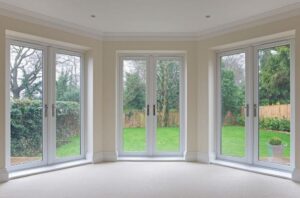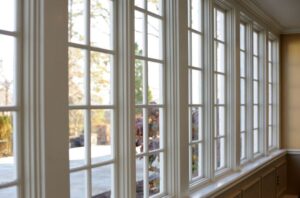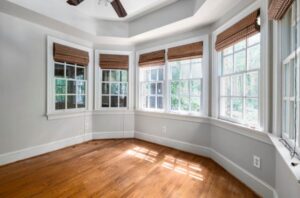Lindsay Windows vs Marvin represents more than a simple brand comparison; it delves into the core of quality and innovation in home fittings.
As pioneers in the windows and doors industry, Lindsay and Marvin each bring unique features and design aesthetics to meet diverse homeowner needs.
The decision between these brands can be complex, with each offering a range of products that promise durability, style, and energy efficiency. This article aims to provide a clear, side-by-side comparison of their offerings.
From detailed product ranges to design options, we will offer insights to help you make an informed choice for your home. Let’s explore the specifics and see how these brands compare in the competitive world of windows and doors.
Lindsay Windows vs Marvin: Comparison Table
| Aspect | Lindsay | Marvin |
|---|---|---|
| Features | Three-point locking, resistant to warping, rust, rot, water damage, color options | Modern and coastal products, resistant to fading, chalking, peeling, cracking, handcrafted designs |
| Product Range | Windows, doors | Windows, doors, skylights, spaces |
| Design Options | Various windows, patio doors | Broad range of windows, doors, skylights, spaces |
| Cost | Windows: $1,100-$1,300, Doors: $900-$3,400 | Windows: $1,000-$1,600, Doors: $2,500-$25,000, Skylights: $175-$3,500, Spaces: $32,000-$80,000 |
| Materials | Vinyl windows, steel and fiberglass doors | Ultrex fiberglass, wood, fiberglass-clad wood frames, wood, aluminum, fiberglass frames |
| Glass Types | EnTech technology, ThermaStar insulated units, Low-E coatings, argon gas fills | Dual and triple pane Low-E coatings, argon gas-filled insulation, textured, decorative, impact-resistant glass |
| Energy Efficiency | ENERGY STAR standards, U-factor: 0.26, SHGC: 0.24 | Exceeds ENERGY STAR standards, U-factor: 0.20-0.48, SHGC: 0.18-0.62 |
| Durability & Longevity | Known for durability | Durable, wood options may need more maintenance |
| Aesthetics | Limited to vinyl, nine exterior colors, woodgrain finishes | Varied materials, custom designs |
| Customization | Moderate, standard sizes and options | Highly customizable, made-to-order designs |
| Technology & Engineering | Innergy and TruSecure technologies | Lock status sensor, European hardware technology |
| Warranties | Lifetime limited, non-prorated, 25-year transferable | 20/10 coverage, transferable limited lifetime, up to 50 years |
| Maintenance & Installation | Routine maintenance, professional installation | Routine maintenance, professional installation |
Key Comparison: Lindsay Windows vs Marvin
When considering Lindsay Windows vs Marvin, it’s essential to delve into their features, product range, and pricing. These elements form the crux of what differentiates one brand from the other.
Features Face-off: Safety, Aesthetics, and Resistance
Lindsay Windows is renowned for its safety features, particularly its three-point locking mechanism.
This not only enhances security but also adds to the overall integrity of the window structure. Coupled with this is Lindsay’s array of color options, catering to diverse aesthetic preferences.
Lindsay also stands out for its resistance to warping, rust, rot, and water damage, which are crucial factors in the longevity and appearance of windows and doors.
On the other hand, Marvin takes pride in its handcrafted designs, which are a blend of modern and coastal aesthetics. This bespoke approach appeals to those who value uniqueness and artistry in their home fittings.
Marvin’s products are also designed to resist fading, chalking, peeling, and cracking, ensuring that they retain their beauty over time.
Diverse Product Range and Design Options
Lindsay’s product line is focused, offering a variety of windows and patio doors. This specialization means that they have honed their craftsmanship in these specific areas.
Marvin, however, offers a more diverse range of products. Their collection includes not only windows and doors but also extends to skylights and spaces.
This broader range means more choices for customers, from standard window designs to more specialized products that can transform a space.
Pricing Analysis: Understanding Value for Money
The pricing structure of both Lindsay and Marvin reflects their market positioning and the value they offer.
| Product | Lindsay | Marvin |
|---|---|---|
| Windows | $1,100 – $1,300 | $1,000 – $1,600 |
| Doors | $900 – $3,400 | $2,500 – $25,000 |
| Skylights | N/A | $175 – $3,500 |
| Spaces | N/A | $32,000 – $80,000 |
Lindsay’s products are generally more affordable, but this does not necessarily mean they are of lesser value. Their pricing strategy aligns with their focus on providing reliable and secure options for windows and doors.
Marvin’s higher price range, especially for doors and exclusive products like skylights and spaces, reflects their emphasis on customization, variety, and high-end design.
Note: It’s important to consider not just the upfront cost but also the long-term value each brand offers in terms of durability, maintenance, and aesthetic appeal.
This analysis reveals that while Lindsay focuses on security and affordability, Marvin emphasizes customizability and variety in design. Your choice will depend on what factors — safety, aesthetics, product range, or price — are most crucial for your needs.
Materials, Glass Types, and Energy Efficiency
The materials used, the technology in glass, and energy efficiency are pivotal in distinguishing Lindsay Windows from Marvin. Let’s delve into how these aspects influence their products’ performance and appeal.
Material Choices and Their Impact on Durability
Lindsay primarily uses vinyl in its windows and a combination of steel and fiberglass in its doors. This selection is a testament to their commitment to providing durable, cost-effective solutions.
Vinyl, known for its resilience and low maintenance, offers a practical option for homeowners. However, it’s worth noting that while vinyl is durable, it may not offer the same longevity or aesthetic versatility as some other materials.
Marvin steps up with a more diverse material palette. Their use of Ultrex fiberglass, renowned for its strength and low maintenance, and wood, known for its classic beauty and insulative properties, caters to a broader range of customer preferences.
The fiberglass-clad wood frames strike a balance between durability and traditional appeal, offering a solution that blends the best of both worlds.
Glass Technology: Enhancing Energy Efficiency
In the realm of glass technology, both brands showcase innovative features:
- Lindsay’s EnTech and ThermaStar Insulated Glass: These technologies signify Lindsay’s focus on energy efficiency. The EnTech technology enhances the thermal performance of the glass, while the ThermaStar insulated glass units offer additional energy efficiency, including options like Low-E coatings and argon gas fills.
- Marvin’s Decorative and Specialty Glazing Options: Marvin’s approach is multifaceted, offering dual and triple pane Low-E coatings and argon gas-filled insulation. This is complemented by a wide range of premium glazing options, including textured and decorative glass. Advanced features like impact resistance cater to specific customer needs, providing both aesthetic and functional benefits.
Comparing Energy Efficiency and Environmental Impact
Energy efficiency is a critical consideration for both brands:
- Lindsay Windows meet ENERGY STAR standards with a U-factor of 0.26 and Solar Heat Gain Control (SHGC) rating of 0.24. These ratings indicate a very good level of energy efficiency, reducing heat loss in winter and heat gain in summer.
- Marvin, however, takes energy efficiency a notch higher. Their products exceed ENERGY STAR standards with a U-factor ranging from 0.20 to 0.48 and SHGC from 0.18 to 0.62. This range suggests that Marvin’s windows can potentially reduce electric costs by 21 to 31 percent, depending on the specific product and its application.
Important Note: While assessing energy efficiency, it’s essential to consider the specific climate and exposure of your home to ensure the best fit for your needs.
In summary, Lindsay’s material choices align with practicality and affordability, while Marvin offers a more diverse range with an emphasis on aesthetics and longevity.
In glass technology and energy efficiency, both brands showcase strengths, but Marvin appears to edge forward with more advanced options and higher energy efficiency ratings.
Which is Better? Delving into Durability, Aesthetics, and Technology
Choosing between Lindsay and Marvin often boils down to specific preferences in durability, aesthetics, and technological advancements. Each brand brings unique strengths to these areas.
Longevity and Maintenance Requirements
Both Lindsay and Marvin are known for their durable products. Lindsay’s focus on materials like vinyl and fiberglass ensures longevity, especially in harsh weather conditions.
Marvin, with its use of Ultrex fiberglass and wood, also promises durability, though their wood options may require more upkeep.
In terms of maintenance, both brands require routine care to maintain their best condition. However, the maintenance needs might vary based on the materials used.
For instance, wood frames from Marvin might need more frequent attention compared to Lindsay’s vinyl options.
When it comes to warranties, both brands offer robust protection, but with differing terms:
- Lindsay: Lifetime limited, non-prorated, with a 25-year transferable limited warranty.
- Marvin: 20/10 coverage, transferable limited lifetime, with products lasting up to 50 years.
Aesthetic Appeal and Customization
Aesthetic appeal is subjective, and both brands cater to different tastes. Lindsay offers nine exterior colors and several woodgrain interior finishes. This range, while impressive, is somewhat limited when compared to Marvin’s offerings.
Marvin steps up with more options in materials and aesthetics, including custom designs. Their ability to offer a broader variety of materials like wood, aluminum, and fiberglass allows for greater customization, matching the unique style preferences of different homeowners.
Technological Advancements and Engineering
Technology plays a crucial role in the performance of windows and doors. Lindsay integrates Innergy and TruSecure technologies, focusing on energy recovery and security. These features enhance the overall functionality of their products, offering a blend of energy efficiency and safety.
Marvin, on the other hand, incorporates lock status sensor technology and European hardware technology in their products. This integration not only adds to the security but also provides a more sophisticated, user-friendly experience.
Note: When choosing between Lindsay and Marvin, consider how each brand’s technology aligns with your specific needs and preferences.
In conclusion, determining which brand is better depends on what you value most: Is it the long-term durability and lower maintenance of Lindsay, or the aesthetic flexibility and advanced technology of Marvin?
Each brand excels in different areas, making the choice a matter of personal preference and specific requirements.
Conclusion: Making an Informed Choice
In summarizing the Lindsay Windows vs Marvin comparison, it’s clear that both brands offer distinct advantages.
Lindsay stands out for its cost-effective, durable products with a focus on safety features, while Marvin excels in aesthetics, custom design options, and advanced technology.
The choice between these two hinges on what you prioritize most: Is it budget-friendliness and straightforward functionality, or are you swayed by innovative designs and cutting-edge technology?
For homeowners and builders, the decision should align with specific needs, preferences, and the architectural style of the property.
Whether it’s the robust and affordable options from Lindsay or the customizable and technologically advanced offerings from Marvin, your choice will significantly influence both the style and functionality of your living space.
Remember, the best choice is one that harmonizes with your lifestyle, budget, and aesthetic desires.





